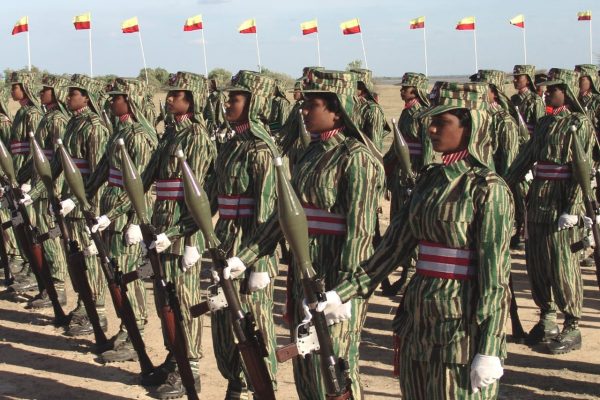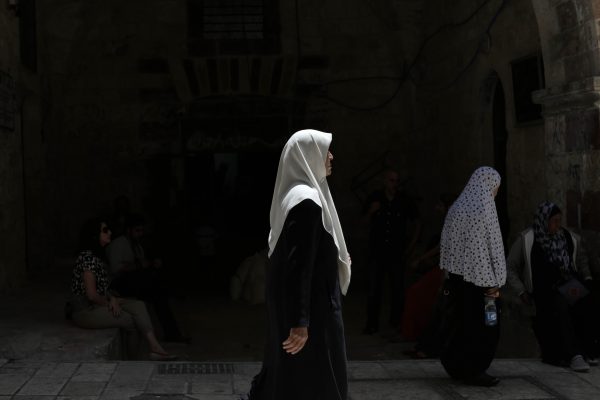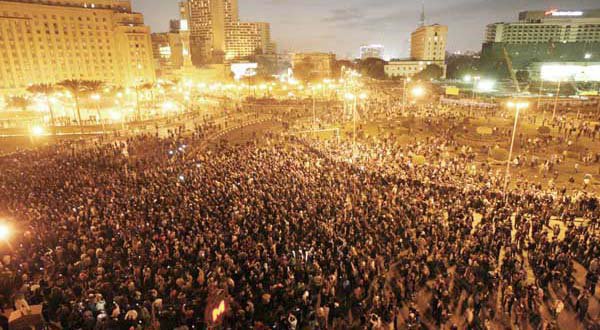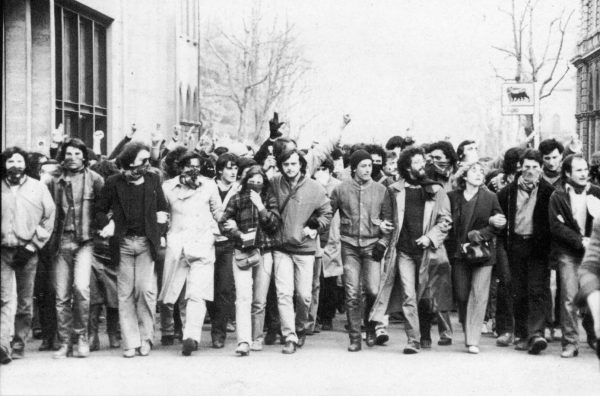THE TRAITOR WHO IS THE WRITER
This is an essay about writing and trauma.
This is an essay about violence: of men, of armies, of women, of relationships, of gossip and memory, of having to remember and having to testify.
This essay is an exercise in intimacy. It questions why women on the margins have to trade in our trauma for the chance to be heard.
This essay in an exercise in trust. I have never discussed my writing – writing as life, as living, as central to my existence and my identity – with any of the men in my personal life. I feel vulnerable enough giving them my love, giving them the pleasure of my body, giving them the power to reject me from one night to the next. I discuss my writing with those who know me only as a writer: my agent, my editors, and most of all, my readers. That is why I bring this essay to you: to show you where some of my writing comes from.
This essay is the story of how I grew up vicariously involved in the armed struggle for Tamil self-determination. This essay is the testimony of what I learned as I listened to other women share their stories of trauma.
This is an essay about three women: a Tamil Tigress, a Tamil Tiger’s wife, and me.
MY STORY
When did my identification with Tamil nationalism begin?
Perhaps it began when I was a newborn baby, barely a few weeks old, and my father was asked to resign from his job as a Tamil teacher at a school in Choolaimedu, Chennai. He remembers the day vividly: 31 October, 1984, the day India’s Prime Minister, Indira Gandhi, was assassinated by her bodyguards. Why was his resignation demanded? My father taught Tamil at the Lalchand Milapchand Dadha Senior Secondary School, a private school run by a Hindi-speaking Jain management. He had crossed the point of no return by politicising his teenage students and taking them along to protest demonstrations. I heard this story repeatedly over my childhood, and remain convinced that when people are punished for their beliefs, it only ends up reinforcing them.
My father was no anomaly. He merely reflected the prevailing mood in Tamil Nadu, our home state in southern India. The civil war in Sri Lanka had begun. A year earlier, in 1983, the deadly Black July pogrom had seen Tamil people in Colombo attacked, murdered and publicly lynched by Sinhalese mobs. The systematic targeting and scapegoating of the Tamil-speaking minority was a standard feature in post-independent Sri Lanka. The Sinhala-Buddhist majoritarian state virtually reduced the Tamils to second-class citizens, passing the Official Languages Act in 1956 which removed Tamil as an official language of the state, and reinforced a Sinhala-only policy which meant that Tamils could not access government jobs, or even intercede with the state in their own mother-tongue. This was followed, in 1972, by a disastrous policy of standardisation, which prevented Tamil students from accessing education and employment on a par with their Sinhalese peers. The burning in 1981 of the Jaffna Public Library, which housed centuries-old rare Tamil manuscripts and histories, was seen as a direct attempt to erase their history. Clampdowns on the Tamil press were common. Against this backdrop of rising ethnic tensions, with the state pursuing an explicitly Sinhala Buddhist agenda, the Tamil Tigers (officially, the Liberation Tigers of Tamil Eelam, or LTTE) – one of many militant groups on the island – had killed thirteen soldiers of the Sri Lanka Army in an ambush in Jaffna on 23 July 1983, in retaliation against the abduction and rape of Tamil schoolgirls by state forces. While the standard, established practice was to send the bodies of the slain soldiers to their hometowns, the Sri Lanka Army Commander Tissa Weeratunga and the Sri Lankan President J. R. Jayewardene decided to bury them with full military honours. Their mangled bodies were brought to the Kanatte cemetery in Borella, in the heart of Colombo, and kept for public display. A delay meant that thousands of Sinhalese had already gathered at the cemetery before the bodies arrived. That crowd morphed into a mob, and armed with electoral rolls to identify Tamil homes, these state-supported rioters ended up killing over 3,000 Tamils, and left about 150,000 homeless overnight.
This caused an unforeseen influx of Tamil refugees into Tamil Nadu. Being neighbours with a shared language and history, who had also stood up to majoritarianism in our own country, we welcomed them with open arms. Tamil people took to the streets to protest, to call upon their own government to step in. From one day to the next, the war on the island began to enter our homes.
*
Perhaps it was the inevitable trajectory for someone who was an Indian Tamil.
Within our one-bedroom home on CNK Road in the gritty Chepauk Triplicane area, the war meant long conversations and a never-ending stream of visitors. It meant that my mother, a mathematics professor, would take on refugee students and appeal to the colleges she knew in Chennai, pleading for them to be admitted. It meant that my father, an unemployed Tamil scholar, would volunteer his proofreading skills to the many printing presses that were being set up by Tamil militant groups to manufacture their pamphlets, posters, campaign material. It meant that when someone came to our home, amma would put water to boil on the stove to make a sugary tea and appa would run downstairs to fetch vadai from the Nair mess at the corner of the street.
This everyday engagement mirrored the wider mood. India set up secret military camps to provide arms training to the Tamil guerrilla groups, ostensibly to protect the Tamils, but primarily to ensure its own supremacy as a regional player. As the civil war in Sri Lanka escalated, India also intervened in an official capacity. Its diplomatic efforts resulted in the Indo-Sri Lanka Peace Accord of 1987, which promised a devolution of power, a conditional merger of the Tamil-speaking Northern and Eastern provinces (the Tamil homeland of Eelam), and the recognition of Tamil as an official language. The accord also promised the disarmament of the Tamil militant groups and an end to the civil war, and stipulated the deployment of an Indian Peace Keeping Force (IPKF) for this purpose.
The force’s arrival was greeted with jubilation by the Tamil people in Eelam, but their initial optimism soon gave way to horror. The IPKF appeared to be working to another mandate altogether. Seeing the Tamil Tigers as a direct challenge to its imperialist ambitions in the region, India was no longer playing peacemaker. Far from being a military presence meant to protect the people, the IPKF soon became a de-facto occupying army, seizing control of the city of Jaffna, storming its hospital, killing civilians, raping women and perpetuating massacres. In August 1989, in retaliation to a Tamil guerrilla attack that killed six Indian soldiers on foot patrol, they turned the small coastal town of Valvettithurai into a scene of bloody carnage, gunning down and murdering more than a hundred civilians, killing babies and burning homes. In the aftermath of such atrocity, the Tigers announced a temporary ceasefire with the Sri Lankan military forces, and joined calls for the IPKF to leave.
As Tamils in India, we were furious at how the Indian intervention had turned out. Our anger turned inwards; it brought us to the brutal realisation that the Tamils were not only fighting the Sinhala state, but another enemy in disguise: India. Disillusionment with our own country made us realise that the Tamil people of Eelam could not rely on external powers to secure their liberation. Instead, we believed, the Tigers held the key to a successful struggle for self-determination.
*
Perhaps it begins with the fact that we were girls in a country where girls were not wanted, not welcome.
Today, we watch the largest armies in the world half-heartedly give women a toe-hold in their ranks. So it was a surprise to many that women formed a third of the fighting force of the Tigers. It was often remarked, in jest, that the biggest recruiter of women for the Tigers was the Indian Peace Keeping Forces, a rapist army whose reign of terror drove women to take up arms.
Growing up, my friends and I looked up to the female Tamil Tigers with admiration, and in their courage and militancy we found the conviction to be strong ourselves. It was a borrowed courage that is difficult to explain. We still lived in a Tamil society where girls were expected to conform to the four quintessential feminine qualities of accham maddam naanam payirppu (fear, ignorance, modesty, shrinking delicacy): we had parental curfews from four in the afternoon and a chaperone wherever we went; no boyfriends, no girlfriends, no short skirts, no jeans. My parents added other layers of oppressive regimenting: no television, no playing loud games outside, no visits to the cinema, no glossy weekly magazines. Across the Palk Strait, where the states of Tamil Nadu and Tamil Eelam were separated by only twenty miles of ocean, young girls like me were carrying AK47s and killing the enemy, and here I was, cowering under the bed in fear of my father waiting with a belt in his hand because a boy in my class had dared to phone me at home. It became easier to forget our own restrictions if we could identify with these warriors who appeared to us like living legends, so real and near, yet somehow distant and mythical, too. It became easier to bear our situation when armed with the knowledge that in a place not far away, Tamil girls just shot the fuck out of anyone who snatched their rights. It was thrilling to lust after the smoking-hot Che Guevara in his beret and his stubble; equally thrilling to lust after these incredibly brave women.
I spent most of my childhood and early teenage years waiting for the liberation they were bringing to their land, and by extension, to Tamil girls like me. I wasn’t the only young, impressionable person out there. Parents were naming their daughters after the fighters (Malathi – the first female martyr in the Tigers, who died in battle fighting the IPKF in 1987, only twenty years old; Vanathi – a poet-fighter who died in the First Battle of Elephant Pass in 1991). It was acknowledged, even among the Tigers, that women were better in armed struggle because they were sharp-shooters. ‘Their concentration is unwavering, they only go for the bulls-eye,’ Vaiko, a senior Tamil politician who had visited the Tigers, said on a stage in Chennai.
To me, their prowess undid the humiliating years when my parents were constantly asked by total strangers, ‘Two girls? Both of them! Why don’t you try for a boy? Never too late, you know!’
Girls were fucking better with guns.
This is an extract from the full essay, published in The White Review No. 28.




